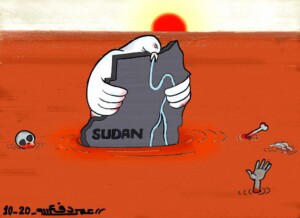Atypical increase in Sudan’s sorghum and millet prices: FEWS NET
According to the Famine Early Warning Systems Network (FEWS NET) atypical price increases for sorghum and millet were observed in Sudan in November.
The increases occurred at a time when prices typically begin to decrease as harvested crops start to arrive in markets.
Sorghum and millet prices abnormally increased by 10 to 40 per cent between October and November 2017. Overall, November levels of sorghum and millet prices were on average 25 to 55 per cent higher than in the same period in 2016, and 50 and 80 per cent higher than the five year average for sorghum and millet, respectively, FEWS NET reported in its Food Security Outlook in December.
According to the Famine Early Warning Systems Network (FEWS NET) atypical price increases for sorghum and millet were observed in Sudan in November.
The increases occurred at a time when prices typically begin to decrease as harvested crops start to arrive in markets.
Sorghum and millet prices abnormally increased by 10 to 40 per cent between October and November 2017. Overall, November levels of sorghum and millet prices were on average 25 to 55 per cent higher than in the same period in 2016, and 50 and 80 per cent higher than the five year average for sorghum and millet, respectively, FEWS NET reported in its Food Security Outlook in December.
Field reports obtained by FEWS NET suggest that some of these increases may be caused by slight delays in harvests this year, combined with shifts in planted area for cereal crops versus cash crops, with prices for the latter more than twice as high than at the same time last year.
The field reports further indicate that farmers are currently accessing sufficient cash income from the sale of cash crops, to allow them to hold on to and sell cereals later in the year at more advantageous prices.
Prices of locally produced wheat continued to increase owing to seasonal factors across most markets since last September. Between October and November 2017, they increased by five to 10 per cent across most markets in Sudan. This increase reflects the trend typical at the end of the season, when market supplies and household stocks are at their lowest.
In November, local wheat prices were on average 40 per cent higher than at the same period last year, and 75 per cent higher than the recent five-year average.
'Encouraging prices'
The State Minister for Finance, Majdi Yasin, told the media on 28 December that the government plans to cut wheat subsidies completely under its 2018 Budget, and will leave wheat imports to the private sector.
The government will buy locally-produced wheat at “encouraging prices”, he said,
According to the State Minister, Sudan imported 2 million metric tons (MT) of wheat in 2017, while local wheat production was 445,000 MT, the UN Office for the Coordination of Humanitarian Affairs (OCHA) in Sudan noted in its latest bi-weekly bulletin.
Sorghum, millet, and wheat are the most important food commodities in Sudan. Sorghum is the staple food for the majority of poor households in central and eastern regions, millet for the majority of households in Darfur and some parts of Kordofan. Wheat is the staple food for the northern Sudanese states.
Harvests
FEWS NET said that main season crop harvests underway since October are likely to continue into January this year.
The harvest of cash crops (sesame and groundnut) is complete, while sorghum and cotton harvests in the irrigated and rain-fed sectors are still underway.
The preliminary findings of the inter-agency Crop and Food Supply Assessment Mission conducted during November-December 2017 suggest average to above-average harvests are likely in most areas of Sudan, except in Kassala, the northern parts of El Gedaref and North Darfur, and the Kordofan region, where cumulative rainfall was below normal between June and September 2017.
Farmers in eastern Sudan’s Kassala en El Gedaref reported to Radio Dabanga last week that they fear for the failure of the winter season because of drought, government neglect, and a lack of harvest workers.
In El Gezira Agricultural Scheme, a lack of irrigation water has caused at least 60,000 acres of corn fields to dry up. A member of the Farmers' Association told this station in December that large quantities of silt in the irrigation canals could not be removed on time because of a lack of fuel to operate the dredges.
He said that the farmers face imprisonment if they do not pay the loans for seeds and pesticides back to the Agricultural Bank of Sudan. “This failure is bound to happen because of the government's deliberate policies to displace the Sudanese farmers and hand over their land to private companies and investors,” he claimed.
390,000 MT of sorghum
In 2017, the UN World Food Programme (WFP) sourced more sorghum from Sudan than ever before, totalling 390,000 MT for use in the country as well as for regional operations.
WFP is at the final stage of its first purchase of sorghum from the Agriculture Bank of Sudan, in addition to a potential strategic partnership agreement with the Strategic Grain Reserve, both of which support local Sudanese farmers and boost the national economy.
This significant increase in locally procured grain illustrates Sudan’s potential to become a food hub for the region, the OCHA bulletin reads.











 and then
and then